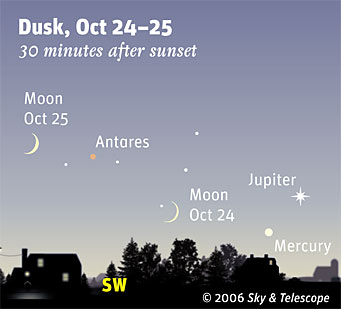
Tony Flanders
A 2½-day-old Moon is always a lovely sight — thick enough to see easily, but still thin enough to look otherworldly. It will be particularly attractive on the evening of Tuesday, October 24th, situated between first-magnitude Antares on its left and the bright planets Mercury and Jupiter on its right.
To enjoy this event to the full, find a location with an unobstructed southwestern horizon, and start scanning the area 15 minutes after the Sun sets. The Moon should be immediately obvious, and you may also be able to see Jupiter without optical aid. Try locating Antares with binoculars, and see how long it takes to become visible to the unaided eye. Mercury is considerably brighter than Antares but also much closer to the horizon, so it will probably be harder to spot. By the end of civil twilight, about a half hour after sunset, you should also be able to see several other of Scorpius's stars through binoculars, and possibly even with your unaided eyes.
Observers in the American Southwest will have an additional treat, as the dark side of the Moon occults Pi Scorpii, the star immediately to its left in the diagram above. Phoenix, Arizona, will be ideally located — the occultation will happen about 6:18 MST (PDT) with the Moon 7° above the horizon in a moderately dark sky. Farther west, the Moon will be higher, but the sky will be brighter. Farther east or north, the occulation will happen longer after sunset, but the Moon will be lower. Make sure you locate Pi Scorpii through binoculars well before the occultation begins.
Please report any interesting observations to [email protected].
 0
0
Comments
You must be logged in to post a comment.